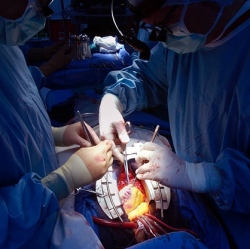
A Michigan baby’s life was saved by the insertion of a 3-D printed trachea at two months old.
The newborn was diagnosed with tracheobronchomalacia, a condition in which the airways collapse, not allowing oxygen to enter the lungs. That, tragically, caused repeated heart attacks. As the doctors said when writing up the case study for the New England Journal of Medicine, “ventilation that was sufficient to prevent recurring cardiopulmonary arrests could not be maintained.”
Doctors then printed a splint that is completely customized to the baby’s tracheal tubes, based on a “computed tomographic image of the patient’s airway.” It’s bioresorbable, made out of a material called polycaprolactone, so it will never need to be withdrawn, and the baby’s body will just naturally absorb and discard the splint within three years.
By that time, doctors say, the baby’s lungs and airways will have developed enough strength to stay open by themselves.
According to LiveScience, prior to 3-D printing, lung splints were carved by hand. 3-D printed splints can be fabricated in a single day, however, and cost about a third as much.
